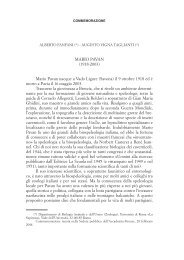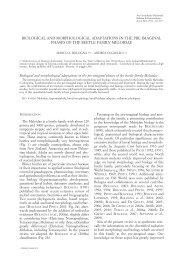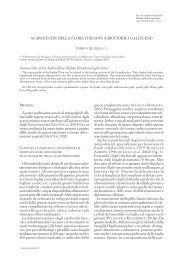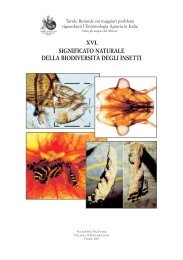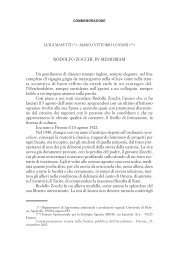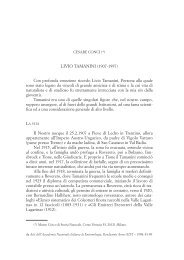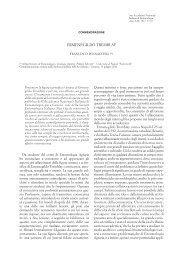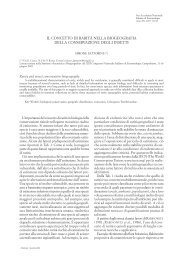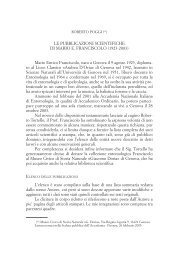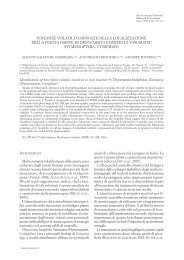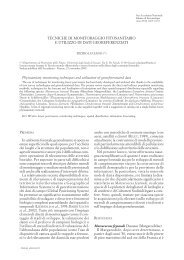XXII CNIE - Accademia nazionale italiana di Entomologia
XXII CNIE - Accademia nazionale italiana di Entomologia
XXII CNIE - Accademia nazionale italiana di Entomologia
Create successful ePaper yourself
Turn your PDF publications into a flip-book with our unique Google optimized e-Paper software.
COLONY COLLAPSE DISORDER—APIS-POCALYPSE NOW?<br />
May R. Berenbaum<br />
Department of Entomology 320 Morrill Hall University of Illinois 505 S Goodwin<br />
Urbana IL 61801-3795<br />
In order to grow and reproduce, virtually all plants require sunlight, water, nutrients, and<br />
some means of reducing the risks of herbivory; for about 80% of the planet’s flowering<br />
plants, an ad<strong>di</strong>tional require is an animal partner to facilitate pollination. In the process<br />
of domesticating crops, humans have over the millennia developed a broad <strong>di</strong>versity of<br />
ways to meet the needs of crop plants for water, nutrients and protection from herbivory.<br />
However, for at least 90 crops in the United States, delivery of pollination services has<br />
been provided almost exclusively by the semi-domestication of one species—Apis<br />
mellifera, the western honey bee. Thus, pollination services contributed by the honey<br />
bee are worth an estimated $15 billion annually (NAS 2007).<br />
Despite this heavy dependency upon a single species, there has been relatively little<br />
investment in improving the apiculture industry and a series of problems experienced<br />
over the last quarter century, inclu<strong>di</strong>ng the accidental introduction of parasitic mites,<br />
small hive beetles, and Africanized bees, has led to a demonstrable decline in both the<br />
number of beekeepers and the number of colonies available for pollination. A study of<br />
the status of pollinators in North America, published in 2007, pointed out the inherent<br />
instability of the beekeeping industry and pre<strong>di</strong>cted that, “if it were to continue to<br />
decline at the rates exhibited from 1947 to 1972 and from 1989 to 1996, it would vanish<br />
by 2035” (p. 118, NAS 2007).<br />
Although the release of the report in October 2006 <strong>di</strong>d not garner much attention, the<br />
pre<strong>di</strong>ctions soon appeared to be prescient. Starting in November 2006, reports began to<br />
surface among American beekeepers of catastrophic losses of unknown origin. Losses<br />
are commonplace in the beekeeping industry, but the constellation of symptoms<br />
characterizing these particular losses, inclu<strong>di</strong>ng a sudden reduction in the number of<br />
foragers, an absence of dead bo<strong>di</strong>es in or near the colony, the presence of abundant<br />
brood, honey and pollen, and an apparent reluctance of hive pests to colonize afflicted<br />
hives, had not been seen previously (van Engelsdorp et al. 2007). Within a year, this<br />
phenomenon, called colony collapse <strong>di</strong>sorder, had been reported in over 30 states in the<br />
United States; similar sudden losses were also reported in Europe, South America, and<br />
parts of Asia. To date, losses associated with CCD have exceeded in duration, magnitude<br />
and extent any previous U.S. <strong>di</strong>sappearances. In the U.S., losses over the winter of 2006-<br />
2007 were estimated at 23% (Cox-Foster et al. 2007) and over the winter of 2007-2008<br />
at 36% (van Engelsdorp et al. 2008).<br />
Extraor<strong>di</strong>nary measures allowed U.S. growers to meet their need for pollination services<br />
despite the spread of CCD; the phenomenon, however, stimulated a renewed interest in<br />
investigating apicultural practices and honey bee biology. Hypotheses, ranging from<br />
plausible to supernatural, proliferated throughout 2007; among the less plausible,<br />
enthusiastically advocated by certain segments of the population but rejected largely on<br />
epidemiological grounds by beekeepers and bee biologists, included genetically<br />
mo<strong>di</strong>fied corn pollen, elevated carbon <strong>di</strong>oxide, cell phones, and jet chemical contrails.<br />
3



